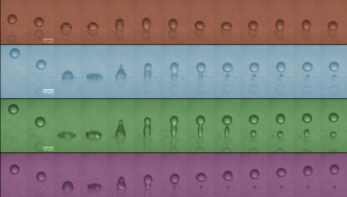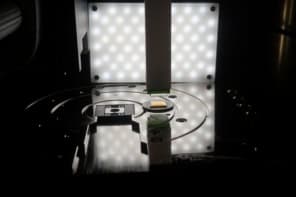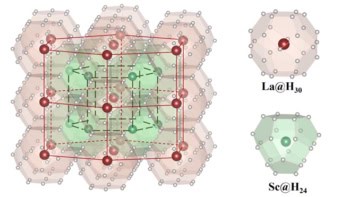
Oppositely charged droplets of the same liquid should attract one another and ultimately coalesce into a single droplet – shouldn’t they? Not always, according to US scientists who have watched such droplets bounce off one another. The team, led by William Ristenpart at the University of California at Davis, has also developed a theory to explain this strange phenomenon, which could be used to develop better ways to remove water from crude oil.
“We only embarked on this line of experiments because of an accident,” says Ristenpart. He and his colleagues were using an oil and water system to study Taylor cones – conical deformations of droplets caused by an electric field.
“I accidentally applied too high an electric field strength, and the water cone extended all the way through the oil and touched the other electrode. Several kilovolts then passed through the water, shorting out the circuit and causing an explosion in the water.”
When Ristenpart turned down the voltage, he saw positively charged drops that were bouncing back and forth between the negative electrode and the surface of a larger, negatively charged droplet. “I thought that was fascinating and very confusing: why were the positively charged drops bouncing off the negatively charged surface?”
Explaining the bounce
Eager to get to the bottom of this mystery, Ristenpart and colleagues used a high-speed camera to investigate why some pairs of colliding droplets repel each other and others coalesce. The answer appears to lie in the shape of a bridge that forms between the drops as they come together, according to the team.
After studying a variety of fluids, including water droplets in silicone oil and brine drops in crude oil, the team found that droplets with a low charge deform, touch and coalesce with larger, oppositely charged droplets in external electric fields of low strength. But if the combination of field strength and charge exceeds a critical value, the smaller droplet bounces off.
Images produced with a high-speed camera capable of 100,000 frames per second revealed that all drops, irrespective of their charge, come into contact by forming a microscopic capillary bridge. This bridge causes an electrical short circuit between the droplets, and the destruction of any electrostatic forces.
The fate of this bridge depends on the geometry of the Taylor cones and the surface tension of the drops. If both droplets have a low charge, blunt, stable cones are formed that grow and suck the smaller droplet into the larger. But if the charge is higher, sharper, unstable cones can form and then break, causing the drops to bounce off one another. In this case, the bridge breaks in less than a millisecond.
Cheaper petrol?
Ristenpart has recently won funding from the American Chemical Society to study this bouncing effect in petroleum. “Electric fields are widely used to separate salt water from crude, and our hypothesis is that the non-coalescence phenomenon dramatically decreases the separation efficiency.”
Osman Basaran from Purdue University describes this work as a “fantastic” result, and is supportive of their theory for coalescence. “I feel that their explanation is a good hypothesis or possibly the sketch of a reasonable theory but one would need to do simulations to be certain.”
Basaran believes that Ristenpart’s work will have an impact in any field where emulsions are used or where there are populations of drops, such as in clouds. “[But] this work will have even a larger impact on researchers, scientists and engineers who try to predict theoretically how populations of charged drops will evolve in time.”
The work is described in Nature.



